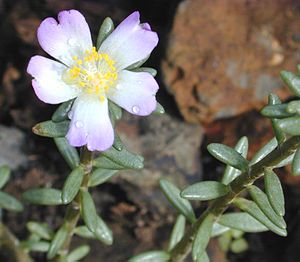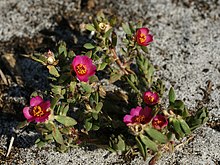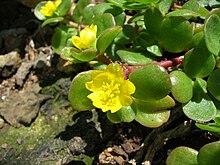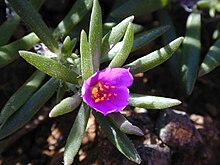Purslane (genus)
| Purslane | ||||||||||||
|---|---|---|---|---|---|---|---|---|---|---|---|---|

|
||||||||||||
| Systematics | ||||||||||||
|
||||||||||||
| Scientific name of the family | ||||||||||||
| Portulacaceae | ||||||||||||
| Yuss. | ||||||||||||
| Scientific name of the genus | ||||||||||||
| Portulaca | ||||||||||||
| L. |
Purslane ( Portulaca ) is the only plant genus of the purslane family (Portulacaceae) in the order of the carnation-like (Caryophyllales) within the flowering plants .
description

Portulaca species grow as annual or perennial herbaceous plants . Many species are succulent due to thickened leaves, thickened shoot axes or storage roots . The stems are erect to creeping. Most of the annual species are tender and tiny.
The leaves are mostly alternate , rarely arranged opposite. The simple, sessile leaves are flat to stalk-round, often fleshy and almost always with entire margins. Stipules are mostly absent; if they are present, they form axillary hairs.
The often terminal, zymose or, more rarely, paniculate inflorescences contain one to 30 flowers and bracts . The sessile flowers are usually large and conspicuous, but short-lived and often cleistogamous . Almost all species are hermaphroditic . Single-sex flowers occur only very rarely and then the species are dioecious separately sexed ( diocesan ). The sepals are probably not genuine, but shifted, modified bracts (bracts), while the petals shifted sepals represent and missing real petals. There are usually many (rarely only four, usually six to 40, rarely up to 100) stamens present. The ovary is subordinate or semi-subordinate. In many species, the flowers only open when the sun is shining, which is why they are called ice flowers like many other species of different genera.
They form capsule fruits that open in cross section and contain many seeds. The tiny seeds are rarely brown, mostly iridescent gray to shiny black and spherical to kidney-shaped.
The chromosome numbers are n = 4, 5, 8, 9.
distribution
The purslane family is widespread all over the world , with the exception of the polar regions . Their main area of distribution is in the southern hemisphere . They mostly thrive in arid tropical and subtropical areas. Main areas of distribution are in Africa and South America. Only a few species inhabit temperate areas.
Systematics
External system


DNA analyzes carried out in recent years have confirmed the long-held assumption that the purslane family does not form a uniform, monophyletic family, but that they are markedly paraphyletic . Because of the great variability of plants, morphological characteristics and even the flower characteristics that are otherwise regarded as “conservative” are not a reliable means of distinguishing between genera and species. As a result, only the genus Portulaca remains in the family today. The vast majority of the genera previously classified here are now part of the Montiaceae family .
Very closely related to the Portulacaceae s. st. are the cactus family (Cactaceae), Anacampserotaceae and Talinaceae . The latest research suggests that these are even nested within the purslane family. If the cacti were to be preserved as an independent family, the purslane family would have to be divided into at least two separate families. Either you leave the Portulacaceae s. l. as a paraphyletic family or - if only monophyletic taxa are allowed - there are monogeneric families like Portulacaceae s. str., Anacampserotaceae and Talinaceae.
Also relatively closely related are the Halophytaceae , Didiereaceae , Basellaceae and Montiaceae , which are in a clade . According to the latest research results, it is proposed to include the previous genera of the purslane family Calyptrotheca , Ceraria and Portulacaria among the Didiereaceae.
Internal system
The first scientific description of the genus Portulaca was in 1753 by Carl von Linné in his work Species Plantarum . The surname Portulacaceae was published in 1789 by Antoine Laurent de Jussieu in Genera Plantarum . The type species is Portulaca oleracea L. Synonyms of the genus are Lemia Vand. (1788), Merida Neck. (1790), Portulacca Haw. (1812, nom. Invalid ICBN -Article 61.1), Lamia Endl. (1839) and Sedopsis (Endl.) Exell & Mendonca (1937).
The genus Portulaca includes the following species:
- Portulaca amilis Speg. : It is found in Argentina, Brazil, Paraguay and Uruguay and is a neophyte in the United States.
- Portulaca argentinensis Speg.
- Portulaca aurantiaca Proctor
- Portulaca bicolor F.Muell.
- Portulaca brevifolia Urb.
- Portulaca bulbifera M.G. Gilbert
- Portulaca californica D.Legrand
- Portulaca cardenasiana D.Legrand
- Portulaca carrissoana (Exell & Mendonça) Nyananyo
- Portulaca caulerpoides Britton & P.Wilson : It occurs in Puerto Rico.
- Portulaca ciferrii Chiov.
- Portulaca clavigera R. Geesink
- Portulaca collina Dinter
- Portulaca colombiana D.Legrand
- Portulaca commutata M.G. Gilbert
- Portulaca confertifolia Hauman
- Portulaca conoidea S.M. Phillips
- Portulaca constricta M.G. Gilbert
- Portulaca conzattii P. Wilson
- Portulaca coralloides S.M. Phillips
- Portulaca cryptopetala Speg.
- Portulaca cubensis Britton & P. Wilson
- Portulaca cyclophylla F. Muell.
- Portulaca decorticans M.G. Gilbert
- Portulaca diegoi Mattos
- Portulaca digyna F. Muell.
- Portulaca echinosperma Hauman
- Portulaca eitenii D.Legrand
- Portulaca elatior Mart. ex Rohrb.
- Portulaca elongata Rusby
- Portulaca eruca Hauman
- Portulaca fascicularis Peter
- Portulaca filsonii J.H.Willis
- Portulaca fluvialis D.Legrand
-
Portulaca foliosa Ker Gawl. ; with the varieties:
- Portulaca foliosa var. Foliosa
- Portulaca foliosa var. Lateritia Poelln.
- Portulaca fragilis Poelln.
- Portulaca frieseana Poelln.
- Portulaca fulgens Griseb.
- Portulaca gilliesii Hook.
- Purslane florets ( Portulaca grandiflora Hook. ): It is native to Argentina, Paraguay and Uruguay.
- Portulaca grandis Peter
- Portulaca halimoides L .: It occurs in North, Central and South America and in the Caribbean.
- Portulaca hatschbachii D.Legrand
- Portulaca hereroensis Schinz
- Portulaca heterophylla Peter
- Portulaca hirsutissima Cambess.
- Portulaca hoehnei D.Legrand
- Portulaca howellii (D.Legrand) Eliasson
- Portulaca insignis Steyerm.
- Portulaca irwinii D.Legrand
- Portulaca johnstonii Henrickson
- Portulaca kermesina N.E.Br.
- Portulaca lutea Sol. ex G.Forst. : It is widespread on islands in the Pacific.
- Portulaca macbridei D.Legrand
- Portulaca macrorhiza Zipp. ex chip.
- Portulaca macrosperma D.Legrand
- Portulaca masonii D.Legrand
- Portulaca massaica S.M. Phillips
- Portulaca mauritiensis Poelln.
- Portulaca mexicana P. Wilson
- Portulaca meyeri D.Legrand
- Portulaca minensis D.Legrand
- Portulaca minuta Correll
- Portulaca molokiniensis Hobdy : It occurs in Hawaii.
- Portulaca mucronata Link
- Portulaca mucronulata D.Legrand
- Portulaca nivea Poelln.
- Portulaca nogalensis Chiov.
- Portulaca obtusa Poelln.
- Portulaca obtusifolia D.Legrand
- Summer purslane ( Portulaca oleracea L. )
- Portulaca oligosperma F.Muell.
- Portulaca olosirwa S.M.Phillips
- Portulaca papulifera D.Legrand
- Portulaca papulosa Schltdl.
- Portulaca paucistaminata Poelln.
- Portulaca perennis R.E.Fr.
- Portulaca peteri Poelln.
- Portulaca philippii I.M.Johnst.
-
Portulaca pilosa L .: It occurs in North, Central and South America. With the subspecies:
- Portulaca pilosa subsp. decipiens (Poelln.) R. Geesink
- Portulaca pilosa subsp. lakhonensis (Gagnep.) R. Geesink
- Portulaca pilosa subsp. okinawensis ( E. Walker & Tawada) R. Geesink
- Portulaca pilosa subsp. pilosa
- Portulaca pilosa subsp. sundaensis (Poelln.) R. Geesink
- Portulaca pilosa subsp. villosa (Cham.) R. Geesink
- Portulaca pusilla Kunth
- Portulaca pygmaea Steyerm.
- Portulaca quadrifida L .: It occurs in the tropics, but is absent in Australia.
- Portulaca ragonesei D.Legrand
- Portulaca ramosa Peter
- Portulaca ramosissima Poelln.
- Portulaca rhodesiana R.A. Dyer & EABruce
- Portulaca rotundifolia R.E.Fr.
- Portulaca rubricaulis Kunth : It occurs in the Caribbean, Florida, Mexico, Venezuela and Ecuador.
- Portulaca sanctae-martae Poelln.
- Portulaca saxifragoides Welw. ex Oliv.
- Portulaca schliebenii Poelln.
- Portulaca sedifolia N.E.Br.
- Portulaca sedoides Welw. ex Oliv.
- Portulaca smallii P.Wilson : It occurs in Georgia, North Carolina, South Carolina and Virginia.
- Portulaca somalica N.E.Br.
- Portulaca stellulato-tuberculata Poelln.
- Portulaca striata Poelln.
- Portulaca suffrutescens Engelm. : It occurs in Arizona, New Mexico and Texas.
- Portulaca teretifolia Kunth
- Portulaca terrae-reginae Poelln.
- Portulaca tingoensis J.F. Macbr .
- Portulaca tuberculata León
-
Portulaca umbraticola Kunth : It is widespread in North, Central, South America and the Caribbean. With the subspecies:
- Portulaca umbraticola subsp. coronata (Small) JF Matthews & Ketron
- Portulaca umbraticola subsp. lanceolata (Engelm.) JFMatthews & Ketron
- Portulaca umbraticola subsp. umbraticola
- Portulaca werdermannii Poelln.
- Portulaca wightiana Wall. ex Wight & Arnott
- Portulaca yecorensis Henrickson & T. Van Devender
swell
- The family of Portulacaceae in APWebsite. (Section systematics)
- Reto Nyffeler: The closest relatives of cacti: insights from phylogenetic analyzes of chloroplast and mitochondrial sequences with special emphasis on relationships in the tribe Anacampseroteae , in American Journal of Botany , 94, 2007, pp. 89-101 .: Online. (Section systematics)
- James F. Matthews: The genus Portulaca - in the Flora of North America , Volume 4, p. 496: Online. (engl.)
- Dequan Lu & Michael G. Gilbert: Portulacaceae in the Flora of China , Volume 5, 2003, pp. 442-444: The genus Portulaca - Online. (engl.)
- JG West: The genus Portulaca on the New South Wales Flora Online . (engl.)
- HR Coleman & Leslie Watson: Portulaca at the Western Australian Flora : Online, 2008.
literature
- R. Matthew Ogburn & Erika J. Edwards: Anatomical variation in Cactaceae and relatives: Trait lability and evolutionary innovation. , in American Journal of Botany , 96, 2009, pp. 391-408.
- Roger Charles Carolin: A review of the family Portulacaceae , in Taxon , 23, 1974, pp. 725-728.
- J. Jage: 47. Family: Portulacaceae , in Illustrierte Flora von Mitteleuropa , 2nd edition, 3 (2), 1979, pp. 1183-1221.
- Roger Charles Carolin: Notas sobre Portulacaceae de la Argentinia , in Parodiana 3 (2), 1987, pp. 329-332.
- BL Nyananyo: The systematic significance of seed morphology and anatomy in the Portulacaceae (Centrospermae) , in Folia Geobot. Phytotax. , 23, 1988, pp. 275-79 & plates 8-13.
- M. Prabhakar, P. Leelavathi, & BKV Kumar: SEM studies on seeds of Indian Portulacaceae and their taxonomic significance , in Asian J. Pl. Sci. 2, 1990, pp. 9-14.
- Roger Charles Carolin: A review of the family Portulacaceae , in Austral. Journ. Bot. , 35 (4), 1993, 383-412.
- LI Malyschev & GA Peschkova (eds.): Portulacaceae - Ranunculaceae , in Flora of Siberia Series Volume 6, 2003.
- Lonnie J. Guralnick, Michael D. Jackson: The Occurrence and Phylogenetics of Crassulacean Acid Metabolism in the Portulacaceae . In: International Journal of Plant Sciences . Volume 162, Number 2, 2001, pp. 257-262, DOI: 10.1086 / 319569 .
- BL Nyanannyo, SI Mensah: Distribution and origins of members of the Family Portulacaceae (Centrospermae) . In: Journal of Applied Sciences & Environmental Management , Volume 8, Number 2, 2004, pp. 59-62.
Individual evidence
- ↑ Basal cactus phylogeny: implications of Pereskia (Cactaceae) paraphyly for the transition to the cactus life form [1]
- ↑ Reto Nyffeler: The closest relatives of cacti: insights from phylogenetic analyzes of chloroplast and mitochondrial sequences with special emphasis on relationships in the tribe Anacampseroteae , in American Journal of Botany , 94, 2007, pp. 89-101 .: Online.
- ↑ Wendy L. Applequist & Robert S. Wallace: Expanded circumscription of Didiereaceae and its division into three subfamilies , in Adansonia , sér. 3, 25 (1), 2003: pdf-Online. ( Memento of the original from November 19, 2006 in the Internet Archive ) Info: The archive link was inserted automatically and has not yet been checked. Please check the original and archive link according to the instructions and then remove this notice.
- ↑ Carl von Linné: Species Plantarum . 1st edition, Lars Salvius, Stockholm 1753, pp. 445-446 (online) .
- ↑ Genera Plantarum, secundum ordines naturales disposita juxta methodum in Horto Regio Parisiensi exaratam . Paris 1789, p. 312 (online) .
- ↑ Urs Eggli: Portulaca . In: Urs Eggli (Hrsg.): Succulent lexicon . Volume 2, Dicotyledons, Eugen Ulmer, Stuttgart 2002, ISBN 3-8001-3915-4 , p. 428.
- ↑ Urs Eggli: Portulaca . In: Urs Eggli (Hrsg.): Succulent lexicon . Volume 2, Dicotyledons (Dicotyledons), Eugen Ulmer, Stuttgart 2002, ISBN 3-8001-3915-4 , pp. 430-433.
- ↑ a b c d e f g h i j k Portulaca in the Germplasm Resources Information Network (GRIN), USDA , ARS , National Genetic Resources Program. National Germplasm Resources Laboratory, Beltsville, Maryland. Retrieved September 20, 2017.
Web links
- Entry in Plants for a Future. (engl.)













